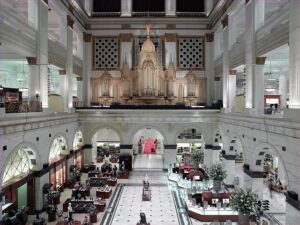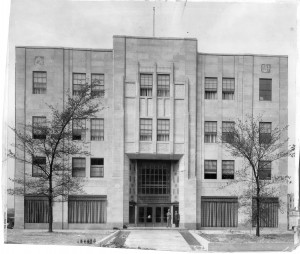
The closing of downtown Philadelphia’s last department store and the collapse of plans to locate the 76er’s arena on east Market Street have opened major questions, not just about the future of Market Street East but about the role of the city’s core more broadly.
Historically, department stores played a major role in anchoring the region. As population growth accelerated outside the city proper, rail transit connected burgeoning suburbs with the city core, where Philadelphia’s “Big Six” department stores offered not just a vast array of merchandise, but unparalleled opportunities to mix with fellow citizens, enjoy fine dining, and participate in civic rituals. Undoubtedly, Wanamaker’s epitomized the civic element of shopping with its grand court and massive organ offering hugely popular concerts. Appropriately, the 1911 store was designed by Daniel Burnam, whose 1909 Chicago plan epitomized what I have called “civitas by design”—using the built environment as a means of enhancing “the community of citizens.”
As decentralization accelerated in the twentieth century, especially under the influence of the automobile, downtown stores attempted to reach customers where they were by opening branch operations. Strawbridge & Clothier led the way, opening at Suburban Square in Ardmore in 1930 and just outside Jenkintown on Old York Road in 1931. By mid-century, however, a whole different variation of the shopping experience emerged in the form of regional shopping centers. Taking advantage of an expanded highway network making shopping accessible to patrons from multiple jurisdictions, the new commercial structures offered a great deal of that civic sociability once associated with downtown department stores. As a pioneer in the genre and developer of the Cherry Hill Mall, opened in 1961 in Camden County, New Jersey, James Rouse liked to describe such centers as maintaining all the best features of the city core, without its attendant nuisances. Like downtown stores before them, these centers, which emerged throughout the region, offered a range of social opportunities, including fashion shows, a variety of dining options, and opportunities to celebrate national holidays and other civic rituals. In addition to affording social encounters with fellow citizens, such spaces became a preferred location for social gatherings. A number of former Camden residents who left the city after the upheaval of the early 1970s, for instance, met for years at the Cherry Hill Mall.

More recently, as the Internet has undermined bricks and mortar stores, the nature of shopping has changed. As individual consumers go online, they encounter neither the salespeople that once guided them to a purchase nor fellow shoppers, whether known or unknown to them. As habits shifted, shopping malls had to adapt in order to survive. While some followed their downtown predecessors by going out of business, others adjusted by incorporating new uses: medical or civic facilities, hotels, housing, and even sports facilities. Such adaptive uses have staved off the extinction of the building type but left the future of such facilities very much in question.
The same could be said for downtown shopping, as evidenced especially by the Gallery at Market Street East, as the development was marketed when it opened in 1977. Heralded for bringing the best of the suburbs (without its attendant nuisance) back to the city, the experiment never really took off. Plopping the 76ers arena down next to its latest iteration as the Fashion District looked a bit like suburban efforts to enliven shopping districts through the attraction of sports. But because professional games have only a limited schedule, the effect would have been limited. The right mix of intended uses could bring life back to the area, while at the same time helping stitch together nearby elements in ways that could help re-establish the area as a central heart to the region.
As Inquirer columnist Inga Saffron reports, the area already is following one lead from refurnished suburban shopping centers by attracting a mix of accessible recreational activities: paintball courses, Formula 1 simulators, arcade games, and indoor bounce houses for kids located into the spaces once occupied by clothing and furniture retailers. These complement other similar newcomers such as Puttshack, at the Shops at Liberty Place on Chestnut Street.
Such investments could help make downtown a desirable destination for more than just the casual visitor. To succeed, however, planners will need to envision a district that moves beyond novelty to enrichment, and here the area’s position between the soon-to-be-reopened Franklin Square SEPTA terminal and Chinatown to the north and the historic district to the south opens new opportunities for blending education and civic celebration with leisure activities. It’s a combination that makes it possible to imagine something so central to a wide range of area residents as well as tourists as to bring back memories of the importance of department stores like Wanamaker’s.